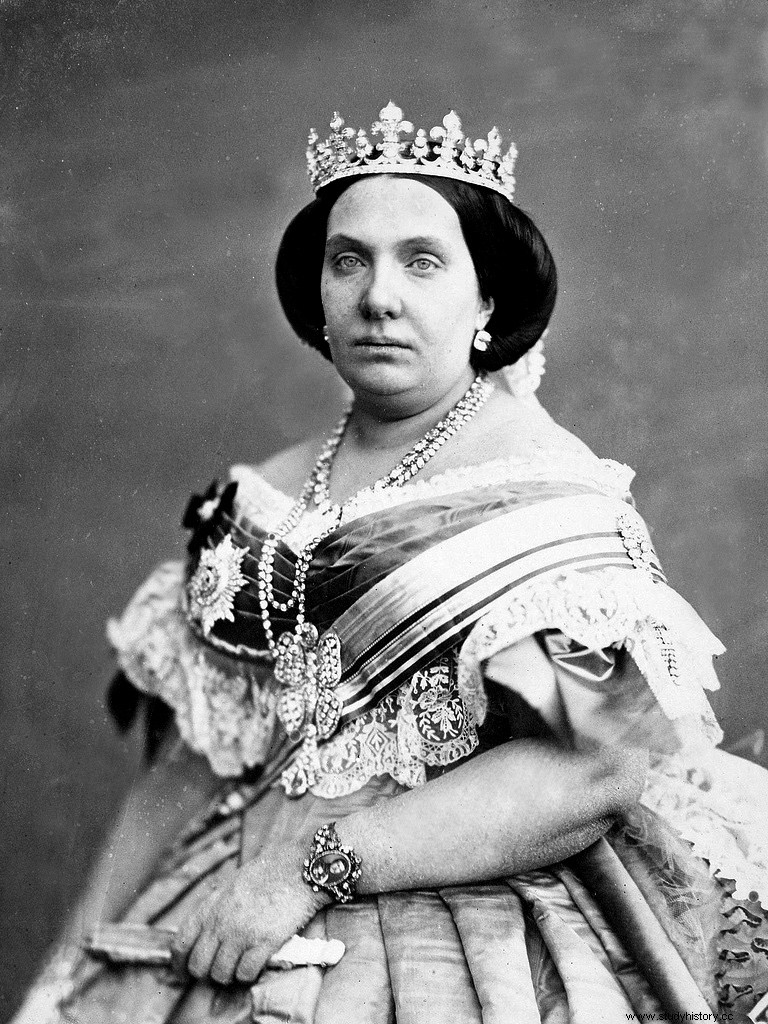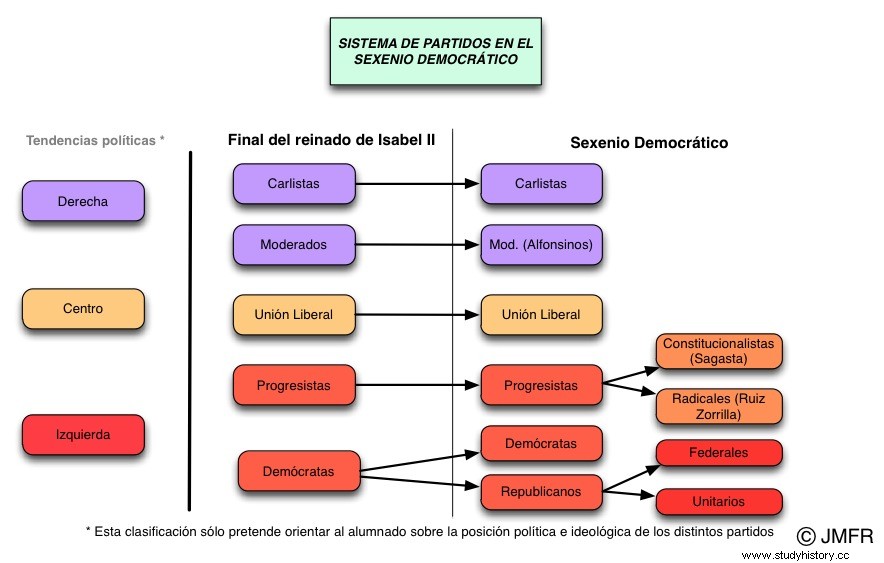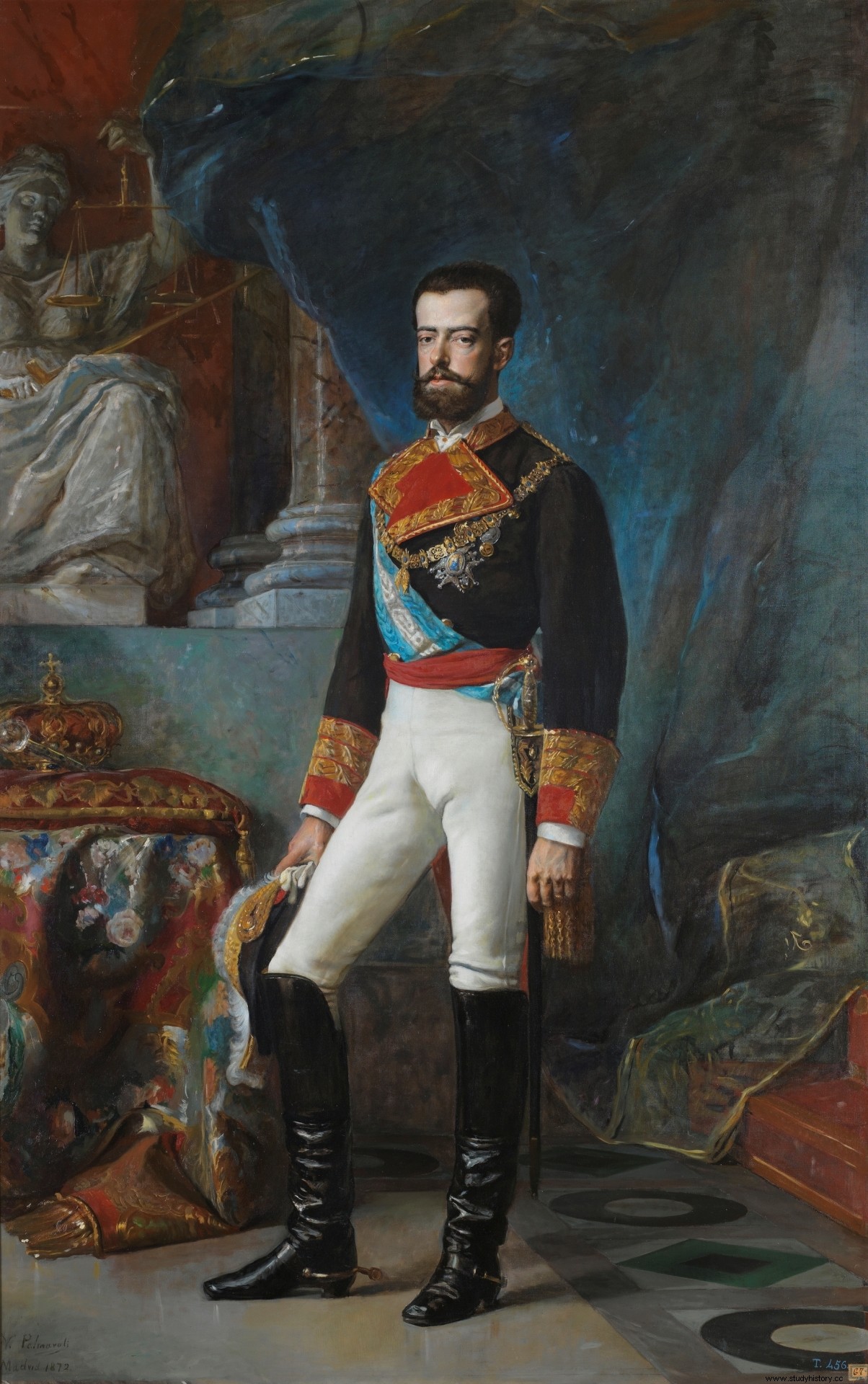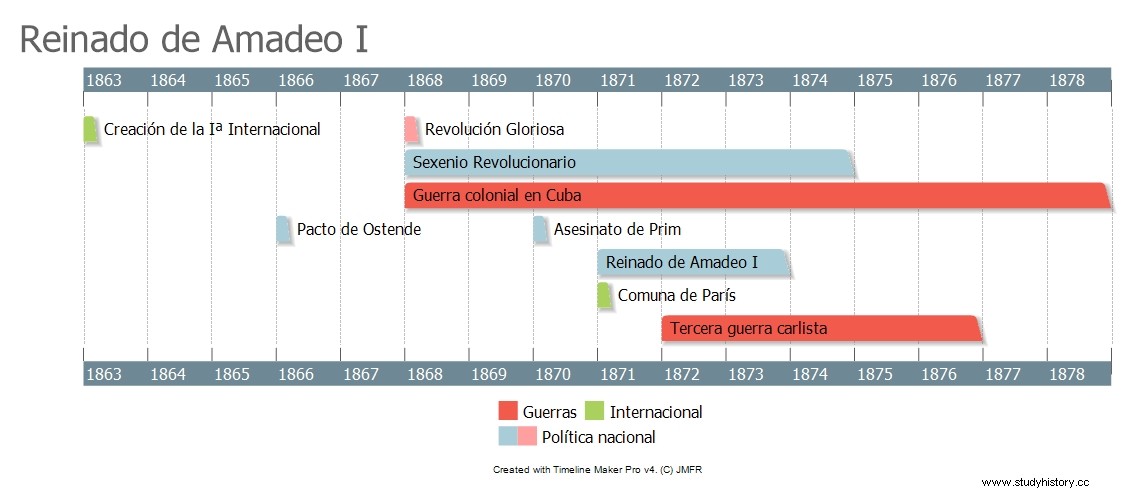The fall of Elizabeth II and the Bourbon dynasty.
The scandals of the final period of the reign of Elizabeth II had ended up causing the absolute discredit of the monarchy and the rise of the Republicans. The fall of the queen was a consequence of the Revolution of 1868, known as the Glorious. Isabel took refuge in France, where she received the protection of Napoleon III and Eugenia de Montijo. In 1870 she abdicated in favor of her son, the future Alfonso XII.

The final period of the reign of Elizabeth II, characterized by the progressive delegitimization of both the political system and the Crown itself, began with the fall of O'Donnell in 1863. The governments, always moderate, had less and less support and the problems increased in all areas. At the same time, the love scandals of the queen and her spouse, Francisco de Asís, eroded the prestige of the Elizabethan monarchy. The increase in repression was the only response to discontent, which showed, on the other hand, the inability of the governments and of the Crown itself to face the general deterioration of the regime.
The permanent alignment of the queen with the moderates and with an elitist political regime, as well as her inability to promote a more democratizing political opening adapted to the social and economic changes that were taking place, ended up signifying the end of her reign and of the dynasty. Bourbon in Spain, albeit provisionally.
The moderate closure caused the progressive and democratic parties to opt for the insurrectionary path to achieve political change. Since 1866 there have been attempts at pronouncements. The signing of the Pact of Ostend (1866) provided a political cover for these attempts and marked a new political objective that went beyond a simple change of government:the dethronement of the queen.

The Glorious Revolution (1868) .
The trigger was the pronouncement of the Navy in Cádiz on September 18, 1868. The military movement also achieved broad civil support since it was backed by democrats and progressives. Its coincidence with a subsistence crisis turned it into a full-fledged revolutionary process. After the triumph of the revolution, Isabel II was dethroned and a period of constant political changes began which, due to its duration, has been known as the Revolutionary Sexenio or the Democratic Sexenio (1868-1874).
At the beginning of October 1868, a provisional government was formed, chaired by General Serrano, who called municipal elections for December. In January 1869, general elections to the Constituent Assembly were held, in which progressives and the Liberal Union (a party that can be considered central) obtained the majority, although the Republicans also achieved good results (85 deputies).
These Cortes drew up the Constitution of 1869, of a progressive nature, although it continued to maintain the monarchy as a form of State. In it, the monarchy depended on national sovereignty, from which all the powers of the State emanated. This raised the problem of finding a new king. This had to be a constitutional monarch, subject to national sovereignty and away from the tendency to interfere in the political game so typical of the reign of Elizabeth II. Ultimately, it was intended to establish a modern model of parliamentary monarchy.
While looking for a new king, a regency was created that Serrano exercised, while Prim would direct the government. The new executive power had to face serious problems:
- A colonial war in Cuba, started in 1868.
- The opposition of the Carlists and the Alphonsines (supporters of restoring the Bourbon monarchy in the figure of Alfonso XII). The Carlists started a new war, the third, in 1872.
- The permanent siege of the republicans, who did not accept the monarchy.
- The discontent of the popular sectors, disappointed by the lack of a government response to their problems

The search for a new king.
Finding a king or queen to replace the Bourbons was a complex operation influenced by both national and international issues. There were five candidates who were rejected for various reasons. This rejection opened the doors to the candidacy of Amadeo de Saboya, second son of the King of Italy Víctor Manuel II.
Amadeo de Saboya's proposal was raised in the summer of 1870 in a troubled context. To the internal divisions that arose among the monarchists due to the support for various candidates, international ones were added, since each country wanted to “place” its candidate. At first, the government announced the candidacy of Leopold of Hohenzollern-Sigmaringen, a Prussian prince, who was opposed by Napoleon III, who feared being surrounded by an enemy dynasty of France. The French ruler also opposed the candidacy of Antonio de Orleans, Duke of Montpensier. This candidate was also not well seen by some Spanish parties because of his family relationship with the Bourbons (he was Isabel II's brother-in-law).
Discarded these candidates, the preferences of the government centered on Amadeo de Saboya, strongly supported by Prim. Amadeo was elected king in a vote of the Cortes on November 16, 1870, with 191 votes in favor, 60 for the federal republic, 27 for Mont pensier, 8 for Espartero and another 25 for other candidates or blank. The prompt death of Prim, assassinated on December 27, 1870, deprived the new king of his main supporter. Even so, Amadeo swore the constitution before the Cortes in early January 1871.

The reign of Amadeus I.
Amadeo I entrusted Serrano with the task of forming the first of his governments. But the division of progressivism between the radicals (Ruiz Zorrilla) and the constitutionalists (Sagasta) made the effort of a joint government impossible. Sagasta, one of the pillars of the political game, was in favor of giving a conservative slant to the new monarchy, fearful of the revolutionary winds that were spreading through Europe at the hands of the Parisian Commune (1871) and the First International (created in 1864). On the contrary, Ruiz Zorrilla was in favor of more progressive measures.
He then entrusted the government to Ruiz Zorrilla, who managed to improve the king's image but ended up resigning after a few months, Sagasta returning to lead the government and calling elections. Despite using the typical mechanisms of electoral fraud, he was unable to prevent the various oppositions to the regime from removing 150 deputies, enough to bring down the government.
After that, the king called Serrano again to form a government, supported by the unionists. But some of his actions –among them the Amorebieta agreement (1972) by which he pardoned the revolted Carlists– provoked the indignation of the military and radicals. Serrano asked the monarch to suspend the constitutional guarantees to which he refused, in response Serrano resigned and the king turned to Ruiz Zorrilla to form what would be the last of his governments. Shortly before, in the summer of 1872, the monarch had suffered a failed attack.
The project to abolish slavery in Puerto Rico, presented on December 24, 1872, aroused at the beginning of 1873 a dark alliance between groups of colonial interests to which all the enemies of the regime joined. Months later, an internal conflict in the Army triggered the resignation of Amadeo I.
Parallel to the political problems mentioned, during his reign there were two civil wars:the third Carlist war and the war in Cuba. This broke out in 1868 and lasted for ten years, until 1978. In it, the members of the "Spanish party" -enemy of any reform of the Antillean economic system- also constituted a front opposing the regime of the new king. For its part, the third Carlist War began in 1872 and took place mainly in the Basque Country, Navarra and Catalonia. It would conclude in 1876.

Conclusions.
The reign of Amadeo I (1870-1873) was a convulsive period. To the political struggles, even among those who theoretically supported him, were added two wars that coincided chronologically. In addition, Amadeo I was never able to gain the trust of the people or of what we can call factual powers – the Church, the Army, a large part of the aristocracy, colonial owners – who did not hide their Bourbon sympathies.
Devoid of the vices of the reign of Elizabeth II, he may have represented the possibility of a modern and democratic parliamentary monarchy. A possibility that the short-termism and personalism of the parties that supported him and the clear opposition of the aforementioned powers made it impossible. His failure opened the door to the First Republic, another convulsive period.
Bibliography.
Amadeus I of Savoy (2016). Recovered from History of Spain. https://historiaespana.es/biografía/amadeo-i-saboya.
Fontana, J. (2007). The era of liberalism. History of Spain (Vol 6). Barcelona:Marcial Pons/Critique.
Inigo Fernandez, L. E. (2010). Brief History of Spain II. The road to modernity. Madrid:Nowtilus.
Martorell, M., &Juliá, S. (2012). Manual of political and social history of Spain (1808-2011) . Barcelona:RBA Books.
Seco, C. (2018) Amedeo I of Savoy. Retrieved from http://dbe.rah.es/biografias/7097/amadeo-i-de-saboya
Van der Brule, A. (2020) The Story of King Amadeus of Savoy:The Great Forgotten on the Run. The Confidential. Retrieved from:https://www.elconfidencial.com/alma-corazon-vida/2020-03-28/amadeo-de-saboya-juan-prim-historia-espana_2521484/
